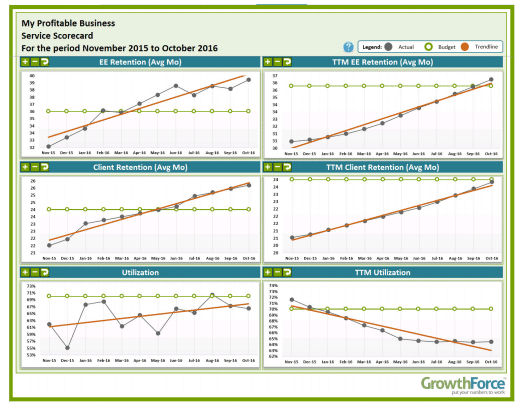.jpeg?width=681&height=454&name=AdobeStock_508385150%20(1).jpeg)
In our eBook, The CEOs Guide to Keeping Score, we address five sections of a CEOs brain to help visualize where, as a strategic CEO, you need to spend your time. Then, we discuss the five related scorecards and KPIs we designed to help CEOs get the information they need to make data-driven decisions.
In this blog, we focus on clients and services and the Services Scorecard.
The back of the CEO brain focuses on the clients and services that drive profitability. Keep in mind profitability by client or job is the most important metric to monitor in Clients & Services. Why?
Because if you make money on other people’s time, chances are, that usually means you’re working on clients or jobs. If you don’t work on clients or jobs, then use "per hour paid" as your unit for unit economics.
Once you’re able to see profit or loss by client or job, then you can tag each job – this allows you to see profitability any way you need to make decisions to improve profits. Tip: You can tag each job with codes that will show your profitability by team, industry, product sales rep or even marketing campaign, and can track where your profits come from.
Tactical and strategic CEOs approach clients and services differently. A strategic CEO focuses on client and employee retention issues and deals with day-to-day service problems. Rather, they think ahead to answer the following questions:
Clients & Services Questions a Strategic CEO should be thinking about:
- Who are my most and least profitable clients?
• Am I pricing my jobs right? Am I getting my target gross profit margin? - Are valuable staff leaving us? Is your knowledge walking out the door?
- Should I hire a new staff member?
• First decide whether you have clients that you should fire, and if you can replace them with better clients to make more profits from people you already have. - Why do clients leave us?
• What service changes do we need to make deliver a “wow” experience?
• Where do we already offer additional value services we could charge for?
The Services Scorecard
The Services Scorecard allows you to analyze how well you manage the effectiveness of your staff.
Charts in the Services Scorecard:
- Employee Retention
- Client Retention
- Utilization

- Employee utilization rate – you can’t look at gross profit per client on the Company Scorecard alone. You also have to look at utilization rate, or the percentage of time staff spend on billable activities. This is because gross profit may be overinflated if staff is not charging their time to clients or jobs. Time leakage may be occurring when the rate of employee utilization is below the company’s goal.
- Employee retention – businesses that make money on their people must keep knowledge workers to build high performing teams. Studying why people leave will help you figure out how to keep your best people in the company as long as possible.
- Client retention – this metric is important if you do repeat business from your clients. if not, track some measure that shows how happy your clients are, such as client referrals, net promoter score or client survey results.
Typically, service businesses want to strive for 80%-85% utilization rates.
A best practice is to look at gross profit and utilization percentages together. Let’s say a job shows a healthy 70% profit margin this month, but the employee utilization rate is just 50%.
That tells us employees are not charging all their time to the job. When the CEO checks the reason for the discrepancy, it may be because employees have been charging time to non-billable activities that nobody is monitoring and the gross margin is artificially inflated.
Or a low utilization rate might also mean that new employees have been hired but the new hires are not yet reaching their full productivity. The results may also indicate that employees are initially spending time in training and not yet serving clients.
Utilization rate helps the CEO know how their people spend their time.
Additional/Advanced Services KPIs
- Profit and loss by customer and job
- Profit and loss by whatever way you have organized your business organization: by the team, department, location; or based on the kinds of sales decisions you need to make: show profitability by sales rep, marketing campaign, industry, product or service.
- Labor Cost as % of income
No matter how you measure it, Clients & Services is a key area for a Strategic CEO to be focusing on; it’s the way you’ll be able to increase utilization rates while keeping your employees working at a reasonable pace.
If you want to learn about the other building blocks for a strategic CEO brain, check out our newest eBook, “Keeping Score” below:

.png?width=563&height=144&name=New%20GF%20Logo%20(37).png)

